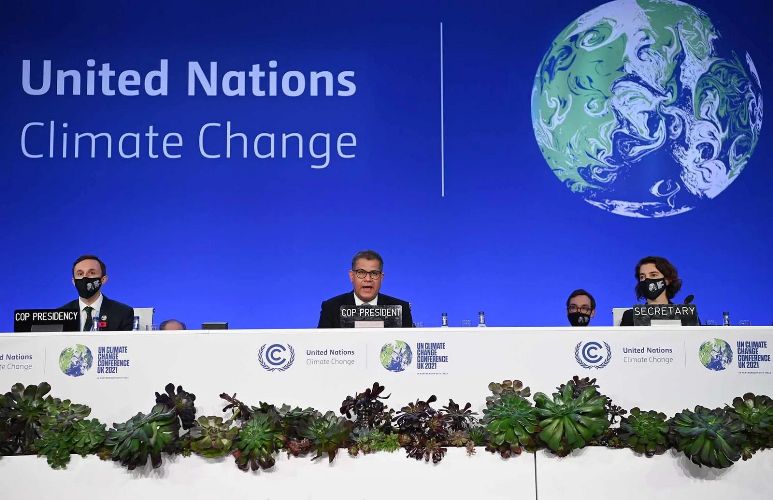Climate change has undoubtedly become one of the most pressing issues of our generation. Despite the increasing prevalence of climate change education, many associate the climate crisis with regards to hotter temperatures, rising sea levels and increased frequency of environmental disasters such as forest fires and typhoons. Few pay attention to the impact that climate change has on our health. In fact, many recent studies have shown how the changing climate can directly impact our health and well-being.

A Polar Bear standing on a melting ice cap. | Photo credit: Kt Miller/ Polar Bears International
Climate Change and Marginalised Communities
Often, ethnic minorities and indigenous people are overlooked when it comes to tackling the climate crisis. Despite indigenous groups’ responsibility for protecting 80 per cent of the remaining biodiversity, they are among the worst affected. To them, nature plays a huge role in the way they live.
To understand the issue better, Professor Ying Zhang, a senior epidemiologist and dedicated researcher and educator for climate change and global health from the University of Sydney, performed a study on the ethnic minorities in Hubei, China. Ying examined the living conditions of minorities living in Hubei, China and realised that their housing areas were especially prone to floods and experienced extreme heat even in mountainous areas.
These groups live with increased vulnerability to social inequalities, reducing their opportunities to engage in discussions about climate change action and thus are often neglected in the public policy domain and public health research. The need to protect the indigenous people and the ethnic minorities from the effects of climate change is important to preserve the practices and heritage these groups have that enrich the culture of their country.

Indigenous people. | Photo Credit: The International Indigenous Peoples Forum on Climate Change
Health Complications of Climate Change
According to the World Health Organisation, climate change makes us more susceptible to health complications such as tropical infections, adverse mental health conditions, pregnancy complications, and even death.
China, for instance, is already experiencing these health effects due to the impacts of pollution, overcrowding, extreme weather events and rising temperatures. The China Lancet Countdown report is the first endeavour of tracking China’s progress across all dimensions of health and climate change with the help of 33 indicators. In 2019, it was recorded that every senior citizen in China experienced an average of 13 more heatwave days than before. Additionally, heatwaves caused 16,800 deaths in China and an increase of 1,000 deaths every 1.2 years over the past decade.
Furthermore, In China, temperature is the eighth risk factor, accounting for six per cent of total deaths. Studies by the International Healthcare Management Forum (IHMF) show that non-optimal temperature is the 11th risk factor for global mortality in both sexes and across all ages. With moderate to extreme non-optimum temperatures, the mortality rate would be about 14 per cent.
Women, Children and Climate Change
Women also constitute to one of the most susceptible groups to climate change as changes in climate conditions can dangerously impact pregnancies which could lead to stillbirths, miscarriages and unwanted abortions. When mothers are exposed to high temperatures or air pollution (both compounded by climate change), the risk of their unborn child being underweight or stillborn increases. This is especially exacerbated for women in marginalised communities.

Mothers protesting on streets for more action taken to protect the environment. | Photo Credit: Jenny Evans / Stringer/ Getty Images
According to new research examining more than 32 million births in the United States, African-American mothers and babies are affected much more severely than other populations. Minorities in the United States are more likely to be affected by the effects of air pollution and global warming as these communities tend to reside in warmer areas located near polluting industries. For every five kilometres that a mother lives closer to a factory plant with high pollutants, the risk of low birth weight increases by three per cent.
If that isn’t already bad enough, mothers with asthma will experience the effects of air pollution even more severely. It has also been reported that severe preterm births increased by 52 per cent for asthmatic mothers exposed to high concentration levels of air pollution. Four studies have also shown that high temperatures create an increased risk of premature births ranging from 8.6 per cent to 21 per cent.
This of course not only affects mothers in the United States but those in lower-income countries. A study based in Africa was conducted by Professor Dean Tong Zhu from the College of Environmental Sciences and Engineering in Peking University shares the relationship between pregnancy loss and ambient PM 2.5 levels which measures the amount of fine matter in the air. In his study across 42,952 cases from 33 countries in Africa, it was evident that higher PM 2.5 levels led to higher miscarriages, pregnancy loss and stillbirths. As such, the concentration of air pollution, as well as high temperatures from global warming, can lead to adverse effects on pregnancies.
On Mental Health
Many studies have also shown that air pollution can give rise to mental health issues. Air pollution can lead to IQ deficits in teenagers, autism spectrum disorders, attention deficit hyperactivity disorder (ADHD), depression, anxiety and psychosis. A British Journal of Psychiatry shows increased use of mental health services as the concentration of air pollution increases.
In recent times, the psychological effects due to climate change have seemingly become more apparent. Climate change can cause eco-anxiety — a fear of environmental adversities also known as climate anxiety. This feeling of vulnerability and emotional distraught has caused individuals to feel anxious making daily life choices. Unlike the anxiety that some of us experience in our day-to-day life, eco-anxiety takes on a different form and is difficult to resolve as climate change is proven to be a pre-existing and inevitable phenomenon. According to a Channel News Asia article, youths, for example, are especially concerned about how climate change and their actions will impact the later generations so they make careful and conscious decisions such as having smaller families.

Climate Demonstrations in New York City. | Photo Credit: Mark Abramson for The New York Times
In 2019, a survey conducted in the United States showed that 57% of teenagers were fearful of climate change and the effects it brings. This collective feeling of fear and anxiety possibly led to many demonstrations on the streets demanding more climate action by the government. In Singapore, our first climate rally happened in 2019 where we saw more than 1,700 participants expressing their environmental concerns as well as demanding more action to be taken.
Additionally, many of these mental health issues arise from the effects of climate change such as droughts, wildfires and typhoons. These disasters have been found to leave long-lasting impacts on victims. In 2017, One in ten people were identified as having a common mental health disorder like depression and anxiety disorders. The life expectancy of those suffering from severe mental illness is reduced by 10-25 years. Thus, the increasing impacts of climate change on our health require enhancing interdepartmental cooperation, strengthening health emergency preparedness, supporting research and awareness and increasing climate change mitigation. Climate change is a transnational issue that affects not just one country but everyone. Countries have to start working together to effectively tackle climate change.
The Good News
Fortunately, many organisations like the Green Fund and the International Fund for Agricultural Development are making the necessary preparations to care for vulnerable communities and to ensure that they are able to thrive during climate shocks.
Many organisations are increasing efforts to educate and raise funds to adequately equip themselves on how to respond to emergencies. Governments, too, are stepping up efforts to protect the environment and its people.
This is evident in the recent 26th United Nations Climate Change conference also known as COP26 where more than 200 leaders from all around the world gathered together in Glasgow, Scotland to unite their efforts in the fight against climate change. Their aims: to limit the rise of global temperatures to 1.5 degrees, adapt to protect communities and natural habitats, mobilise finance, and lastly, to work together to deliver.

Leaders gathered at the COP26 summit. | Photo Credit: Jeff J Mitchell/Getty Images
Additionally, governments in developing countries can break the negative feedback loop of poverty by implementing inclusive development policies that are aligned with climate stabilisation while reducing inequality.
Governments can also improve social safety nets and pass laws that enable the marginalised to better cope with the severe impacts of climate change. Countries can also implement stricter penalties on companies who produce carbon emissions that are above the acceptable levels to reduce air pollution that causes many health implications. Our part as citizens should be electing governments that are creating policies that tackle climate change. We need world leaders who are concerned about this issue as much as we are.
Climate change and its impacts are more than what we can imagine. It does not just harm our environment but it can also harm public health. There is more we can do, we can use our voices to demand more action by the government to protect our environment. We do not have a choice anymore – whether to sit back and relax or to take action. It is time to start doing more to protect ourselves and preserve our environment. We can only reach our goal if we all do our part to save our environment collectively.
This article was first published on THE IAS GAZETTE (10 Feb 2022).
Posted 22/03/2023

















